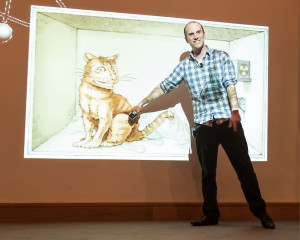February 10, 2014
What’s at the bottom of a Black Hole?
Colin Stuart
Report by: Chris Sutcliffe
Colin Stuart is part of the Royal Observatory astronomy team. When not at Greenwich, he writes about science, penning articles for New Scientist, The Guardian, The Observer, BBC Sky at Night magazine and the European Space Agency among many others. His first book – The Big Questions in Science – was published in September 2013, in which he takes on some of the most challenging topics in physics and astronomy today. A Fellow of the Royal Astronomical Society, he has also climbed the Lovell radio telescope, talked aliens and eclipses on TV and seen the death mask of Sir Isaac Newton!
Colin introduced his talk by saying that we are not going to be here forever as the Earth has a sell-by date! The Sun will expand, and in around 4 billion years, the temperature on Earth will be about 200 degrees Celsius, with the result that water will boil away; as far as we know, life cannot exist without water. The Sun will also swallow up Mercury and Venus.
The Sun will eventually become a planetary nebula. If the mass of a star is less than 8-times the mass of the Sun, that object will eventually become a planetary nebula. Colin showed a slide of the Crab Nebula (in the constellation of Taurus), which has an incredibly dense neutron star at its centre, only about 30km across. If a star is more than 8 times the mass of the Sun, it dies in a different way; a supernova explosion which is what happened here in 1054AD to create the Crab Nebula. Chinese astronomers noticed a new start at that time, which was visible in the daytime.
How big an object is determines what is left behind. If the mass of the object is between 8 and around 30 to 40-times the mass of the Sun, the object ends up as a neutron star. If it is more than 30 to 40-times the mass of the Sun, it becomes a black hole.
In a white dwarf, all the matter is packed into an object the size of the Earth; in the case of a neutron star, all the matter is packed into an object the size of London! A tea-spoonful of material from a neutron star would weigh more than every single person on Earth. The magnetic field of a neutron star increases significantly, and it spins very quickly and jets flow out from its poles. Colin showed a graph to illustrate the relationship between the area of an object and the strength of its magnetic field, demonstrating that the smaller the surface area, the greater the magnetic field.
In an X-ray image of the centre of the Crab Nebula, the neutron star can be seen with jets coming from its poles. The object in the Crab Nebula spins at 30 times a second.
Planets orbit round the sun at 6,000 to 7,000 miles per hour. A black hole is a collapsing star that is so dense that it rips a hole in space. To escape the Earth you need to reach a speed of 11km per second. To leave a black hole, you would need to reach beyond the speed of light. A black hole is black because no light can escape from it. If you crushed the Earth down to the size of your thumbnail, it would be black hole.
If you were to go down into a black hole, according to Einstein, everything keeps collapsing down until it is infinitely small. This point is known as a singularity. We are squeezing something down to next to nothing. General relativity deals with the big stuff, and quantum mechanics with the very small stuff. Black holes seem to be at the crossover between them. If we combine these two theories, we may be able to explain everything in the universe.
However, so far, despite all of our efforts, we are not much closer to determining what is at the bottom of a black hole!
This was a most interesting lecture in which a difficult subject was clearly explained.
Pictures from the Evening (by Mike Meynell):
Posted under: Flamsteed, Flamsteed Lecture, Meeting Report







You must be logged in to post a comment.